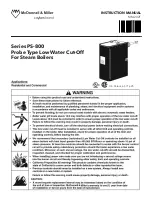
45
LP- 325 REV. 3.3.15
I. CONDENSATE REMOVAL SYSTEM
NOTE:
Check with your local gas company to determine if combustion condensate disposal is permitted in your area. In the state of
Massachusetts, condensate must be neutralized before entering a drain.
This condensing high efficiency appliance has a condensate removal system. Condensate is water vapor derived from combustion
products, similar to an automobile when it is initially started. It is very important that the condensate line is sloped down away from the
appliance and to a suitable drain.
If the appliance condensate outlet is lower than the drain, you must use a condensate removal pump (kit 554200 available from HTP). If
required by local authorities, a condensate filter of lime crystals, marble, or phosphate chips will neutralize slightly acidic condensate.
This can be installed in the field and purchased from HTP (7450P-212).
Plastic tubing must be the only material used for the condensate line. Steel, brass, copper or other materials will be subject to corrosion
or deterioration. A second vent may be necessary to prevent a condensate line vacuum lock if a long horizontal run is used. An
increase in condensate line diameter may be necessary to allow condensate to drain properly. Support of the condensate line may be
necessary to avoid blockage of the condensate flow.
Figure 21
– Condensate Line Detail
NOTES:
1. Condensate line must be pitched at least 1/4" per foot to properly drain. If this cannot be done, or a very long length of condensate hose is
used, you must increase the condensate line to a minimum of 1” ID and place a tee in the line after the condensate neutralizer to properly
reduce vacuum lock in the drain line.
2. Plastic pipe should be the only material used for the condensate line. Steel, brass, copper, or other materials will be subject to corrosion or
deterioration.
3. NEVER install condensate lines outside. It is very important that the condensate line is not exposed to freezing temperatures or any type of
blockage. Damages due to frozen or blocked condensate lines ARE NOT covered by warranty.
4. Support of the condensate line may be necessary to avoid blockage of the condensate flow.
The condensate line must remain unobstructed. If allowed to freeze in the line or obstructed in any other manner, condensate can exit
from the water appliance tee, resulting in potential water damage to property.
When installing a condensate pump, select one approved for use with condensing appliances and furnaces. The condensate pump
should have an overflow switch to prevent property damage from spillage. Condensate from the appliance will be slightly acidic (pH
from 3.2 to 4.5). Install a neutralizing filter if required by local codes.
Summary of Contents for Pioneer
Page 17: ...17 LP 325 REV 3 3 15 Figure 3 Dimensions ...
Page 28: ...28 LP 325 REV 3 3 15 Figure 9 DHW Pack Performance on 199K BTU Models ...
Page 44: ...44 LP 325 REV 3 3 15 Figure 20 ...
Page 47: ...47 LP 325 REV 3 3 15 Figure 22 Internal Wiring Diagram ...
Page 67: ...67 LP 325 REV 3 3 15 Figure 30 Pioneer and Versa Flame ...
Page 68: ...68 LP 325 REV 3 3 15 Figure 31 Pioneer and Versa Flame ...
Page 71: ...71 LP 325 REV 3 3 15 ...
Page 72: ...72 LP 325 REV 3 3 15 ...
















































